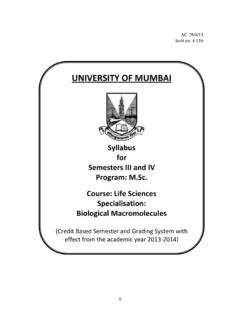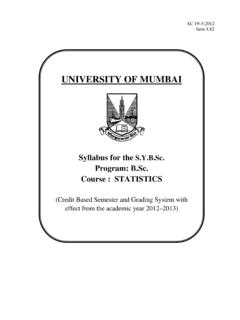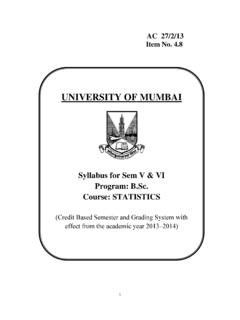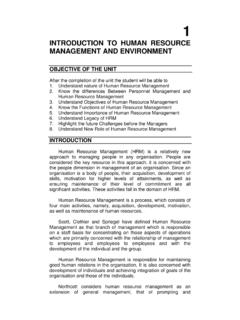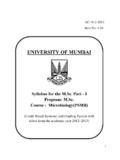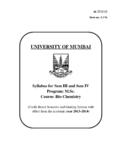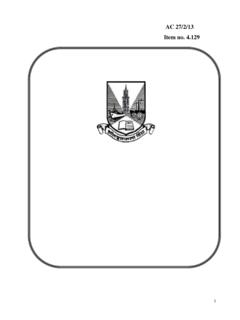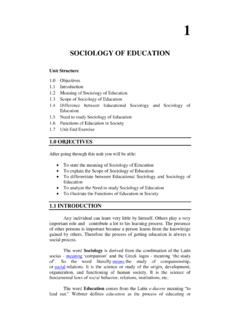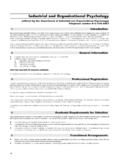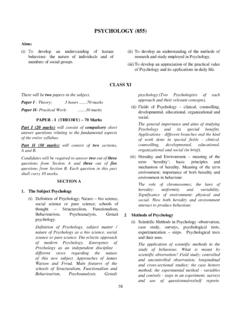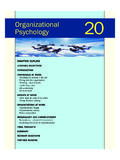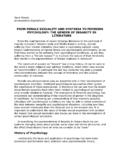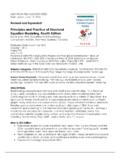Transcription of Revised Syllabus V Sem. VI Program: B.A.
1 1AC 29/4/13 Item no. UNIVERSITY OF MUMBAI Revised Syllabus Sem. V & Sem. VI Program: Course: psychology (As per Credit Based Semester and Grading System with effect from the academic year 2013 2014) 2 Credit Based Semester and Grading System psychology Syllabi to be implemented from 2013 2014 Psychological Testing and Statistics: Parts I and II (Special course; Paper IV in old scheme) Code Sem. Course Title Credits Marks UAPS501 5 Psychological Testing and Statistics: Part I 4 100 ( 60 +40) UAPS601 6 Psychological Testing and Statistics.
2 Part II 4 100 ( 60 +40) Objectives - 1) To impart knowledge and understanding of the nature, uses, technical features, and the process of construction of psychological tests 2) To create awareness about measurement of intelligence and assessment of personality 3) To impart knowledge and understanding of the basic concepts in Statistics and the various measures of Descriptive Statistics - their characteristics, uses, applications and methods of calculation 4) To create a foundation for advanced learning of Psychological Testing, Assessment, and Statistics Semester 5. Psychological Testing and Statistics: Part I (Credits = 4) 4 lectures per week; 60 lectures per Semester Unit 1. Psychological Testing and Assessment a) Definition of testing and assessment; the process and tools of assessment b) The parties and types of settings involved c) How assessments are conducted; assessment of people with disabilities Unit 2.
3 Tests, Testing and Norms a) Reference sources for authoritative information about tests b) Various assumptions about Psychological Testing and Assessment c) What is a Good Test ; Norms sampling to develop norms, types of norms, fixed reference group scoring systems, norm referenced versus criterion referenced evaluation d) Inference from Measurement meta analysis; culture and inference Unit 3. Reliability a) The concept of Reliability; Reliability estimates: Test Retest, Parallel and Alternate Forms, Split Half, Inter Item Consistency Kuder Richardson formulas, Cronbach s Coefficient Alpha; Inter Scorer Reliability b) Using and interpreting a coefficient of Reliability purpose and nature of the test 3c) Alternatives to the true score model: Generalizability theory and Item Response Theory d) Reliability and individual scores: SEM and SE Difference Unit 4.
4 Validity a) The concept of Validity b) Content Validity c) Criterion related Validity d) Construct Validity e) Validity, bias, and fairness Unit 5. Types of scores, Types of scales, Frequency Distribution and Graphic representations a) Continuous and discrete scores meaning and difference b) Nominal, ordinal, interval and ratio scales of measurement c) Preparing a Frequency Distribution; advantages and disadvantages of preparing a frequency distribution; smoothed frequencies: method of running averages d) Graphic representations: Frequency polygon, histogram, cumulative frequency curve, ogive, polygon of smoothed frequencies (Unit 5-d is only for theoretical understanding and questions; graphs are not to be drawn in the exam.) Unit 6. Measures of central tendency a) Calculation of mean, median and mode of a frequency distribution b) The assumed mean method for calculating the mean c) Comparison of measures of central tendency: Merits, limitations, and uses of mean, median and mode Semester 6.
5 Psychological Testing and Statistics: Part II (Credits = 4) 4 lectures per week; 60 lectures per Semester Unit 1. Test Development a) Test conceptualization b) Test construction c) Test tryout d) Item analysis e) Test revision Unit 2. Measurement of Intelligence and Intelligence Scales a) What is Intelligence? - Definitions and theories; measuring Intelligence b) The Stanford-Binet Intelligence Scales c) The Wechsler Tests: WAIS, WISC, WPPSI d) Close-up: Factor analysis Unit 3. Assessment of Personality a) Personality Assessment some basic questions b) Developing instruments to assess personality logic and reason, theory, data reduction methods, criterion groups; personality assessment and culture c) Objective methods of personality assessment 4d) Projective methods of personality assessment - Inkblots as Projective stimuli - the Rorschach; Pictures as Projective stimuli Thematic Apperception Test; Projective methods in perspective Unit 4.
6 Probability, Normal Probability Curve and Standard scores a) The concept of Probability; laws of Probability b) Characteristics, importance and applications of the Normal Probability Curve; Area under the Normal Curve c) Skewness- positive and negative, causes of skewness, formula for calculation d) Kurtosis - meaning and formula for calculation e) Standard scores z, T, stanine; linear and non-linear transformation; Normalised Standard scores Unit 5. Measures of Variability, Percentiles, and Percentile Ranks a) Calculation of 4 measures of variability: Range, Average Deviation, Quartile Deviation and Standard Deviation b) Comparison of 4 measures of variability: Merits, limitations, and uses c) Percentiles nature, merits, limitations, and uses; Calculation of Percentiles and Percentile Ranks Unit 6.
7 Correlation a) Meaning and types of correlation positive, negative and zero b) Graphic representations of correlation - Scatterplots c) The steps involved in calculation of Pearson s product-moment correlation coefficient d) Calculation of rho by Spearman s rank-difference method e) Uses and limitations of correlation coefficient f) Simple Regression and Multiple Regression Book for study Cohen, J. R., & Swerdlik, M. E. (2010). Psychological Testing and Assessment: An introduction to Tests and Measurement. (7th ed.). New York. McGraw Hill International edition 1 assignment of 10 marks in each Semester Broad Topics for the assignments for Semester 5 and 6 are given below. The teacher in charge should prepare a list of various sub topics under these broad topics and assign different specific topics to the students in the class to ensure maximum possible coverage of the suggested topics.
8 The students should refer to the relevant books and present information about the specific assigned topic in written or typed form maximum 1000 words, 2 full pages (4 sides) of A 4 size paper. Additional pages (maximum 2 or 3) may be used for Bibliography and Tables, Figures and Appendix if any. Assignments of a very high quality may be given maximum 9 marks out of 10. 1. History of Psychological Testing and Assessment 2. Culture and assessment 3. Legal and Ethical considerations of testing and assessment 4. The rights of test-takers 5. Definitions of personality and personality assessment; personality traits, types and states 56. Projective methods of Personality Assessment - Rosenzweig Picture-Frustration Study test; Words Projective stimuli Word Association and Sentence Completion tests; Sounds as Projective stimuli; Production of figure drawings - figure drawing tests Books for reference 1) Aiken, L.
9 R., & Groth-Marnat, G. (2006). Psychological Testing and Assessment. (12th ed.). Pearson. Indian reprint 2009, by Dorling Kindersley, New Delhi 2) Anastasi, A. & Urbina, S. (1997). Psychological Testing. (7th ed.). Pearson Education, Indian reprint 2002 3) Aaron, A., Aaron, E. N., & Coups, E. J. (2006). Statistics for psychology . (4th ed.). Pearson Education, Indian reprint 2007 4) Gregory, R. J. (2004). Psychological Testing: History, Principles, and Applications. (4th ed.). Pearson Indian reprint 2008, by Dorling Kindersley India pvt ltd, New Delhi 5) Hoffman, E. (2002). Psychological Testing at Work. New Delhi: Tata McGraw-Hill 6) Hollis-Sawyer, , Thornton, G. C. III, Hurd, B., & Condon, (2009). Exercises in Psychological Testing. (2nd ed.). Boston: Pearson Education 7) Kaplan, R.
10 M., & Saccuzzo, D. P. (2005). Psychological Testing Principles, Applications and Issues. (6th ed.). Wadsworth Thomson Learning, Indian reprint 2007 8) Kline, (2005). Psychological Testing: A Practical approach to design and evaluation. New Delhi: Vistaar (Sage) publications 9) Mangal, (1987). Statistics in psychology and Education. New Delhi: Tata McGraw Hill Publishing Company Ltd. 10) McBurney, (2001). Research Methods. (5th ed.). Bangalore: Thomson Learning India 11) McIntire, , & Miller, (2000). Foundations of Psychological Testing. (1st ed.). McGraw-Hill Higher Education Pattern of Question Paper for class test of 20 marks The class test can be conducted in the class or if the technical facilities are available, it can be conducted online.

